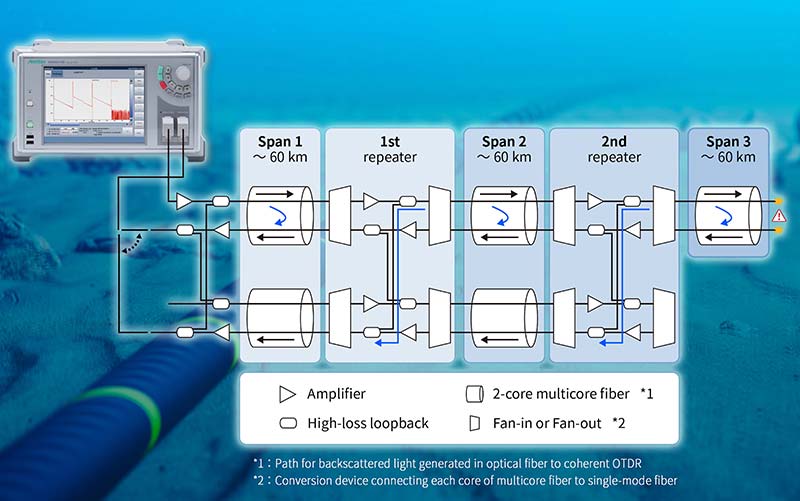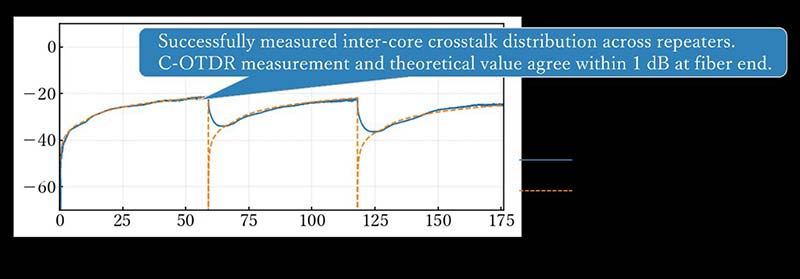
World’s First Successful Remote Diagnosis for Multicore Optical Fiber Cable by Anritsu and KDDI Research
Anritsu and KDDI Research have, for the first time in the world, designed a remote monitoring system for next-generation optical submarine cables using multicore optical fiber (Note 1), and have successfully demonstrated the measurement of optical path characteristics (Note 2) in a trial environment (Note 3) (hereinafter, “this trial”).
In this trial, leveraging the expertise of KDDI Research, a trial environment was established for an optical submarine cable system incorporating an optical circuit that enables remote monitoring with multicore optical fiber. Within this trial environment, Anritsu’s optical pulse tester “Coherent OTDR (Coherent Optical Time Domain Reflectometer) (Note 4) MW90010B” (Note 5) was used to confirm the ability to measure optical path characteristics such as fault location and fiber loss profile, which is essential for the operation and maintenance of submarine cables.
This achievement makes it possible to remotely visualize the quality and faults of multicore optical fiber, which had previously been difficult, greatly enhancing the reliability and operational efficiency of optical submarine cables.
Both companies will unveil these achievements at “The 51st European Conference on Optical Communication (ECOC 2025)”, the world’s largest international conference on optical communications, to be held in Denmark from September 28 to October 2, 2025. (Note 6)
About the Trial
1.Background
With the rapid proliferation of AI and IoT technologies, global data traffic is expected to continue increasing dramatically, driving the need for even greater capacity in optical submarine cables that support international communications. Currently, optical submarine cable systems utilize single-mode fibers, which contain a single optical path (hereinafter “core”) per fiber. However, as there are space limitations to increasing capacity using a single core, recent years have seen growing interest in multicore fibers, which incorporate multiple independent cores within a single optical fiber. This approach enables a significant increase in transmission capacity per optical fiber.
As the introduction of multicore fiber is further explored, there is also a need for new technological advancements in system operation and maintenance. At present, the operation and maintenance of optical submarine cable systems using single-mode fibers rely on coherent OTDR technology to locate fiber breaks and measure losses, thereby ensuring optical path quality. However, in multicore fibers, there is a unique degradation factor known as inter-core crosstalk (Note 7), which may affect measurement (Note 8) accuracy when using coherent OTDR. To date, with coherent OTDR, measuring the optical path characteristics in optical submarine cable systems employing multicore optical fiber has been a significant challenge. (Note 9)
2.Achievements
In this trial, we investigated whether the optical path characteristics of multicore fiber could be measured using coherent OTDR, in the same way as with single-mode fiber.
KDDI Research has newly designed a transmission system that enables measurement using a coherent OTDR, even with multicore optical fiber, and constructed a simulated environment for an optical submarine cable system using multicore fiber, leveraging its extensive research experience and expertise in optical submarine cables. In this simulated environment, measurement light transmitted from Anritsu’s “Coherent OTDR MW90010B” propagates through the multicore optical fiber. The reflected and scattered light generated within each core is then returned to the coherent OTDR for reception and analysis, enabling the measurement of optical path characteristics.
As a result of this trial, we succeeded for the first time in the world in confirming that coherent OTDR can be used to detect faults and measure fiber loss profile in optical submarine cable systems employing multicore fiber. Furthermore, by utilizing the measurement results of coherent OTDR, it was also confirmed that the distribution of inter-core crosstalk along the fiber, including through repeaters, can be measured. This marks the world’s first successful visualization of inter-core crosstalk over long distances.
This achievement demonstrates the practical applicability of conventional coherent OTDR for multicore fiber, and is expected to accelerate the adoption of multicore fiber in optical submarine cable systems while ensuring high communication quality.
Anritsu and KDDI Research will continue to collaborate on research and development to further increase the capacity of optical submarine cables and ensure stable international communications.
Notes
(Note 1) A type of optical fiber with multiple optical path (cores), designed to suppress interference of optical signals between the cores.
(Note 2) The various properties and characteristics, such as fiber loss, that occur when optical signals are transmitted through transmission paths like optical fibers and repeaters.
(Note 3) As of September 2025, this is the world’s first measurement of optical path characteristics in an optical submarine cable system using multi-core optical fiber with a coherent OTDR (according to research by both companies).
(Note 4) An optical pulse testing instrument utilizing coherent (optical heterodyne) detection technology. It receives and analyzes the return light of the probe signal sent by the coherent OTDR using coherent detection techniques. It is well-suited for measuring the characteristics of optical fibers in submarine cables, which are repeatedly amplified by optical repeaters.
(Note 5) Coherent OTDR MW90010B
(Note 6) ECOC2025(Bella Center)Presentation Information: September 29, 2025, 16:00–16:15 (local time)
Session:M.03.08 Fiber-Optic Sensing SC 8: Sensing and microwave photonics
Title:Impact of Inter-Core Crosstalk on Coherent Optical Time-Domain Reflectometry in Repeatered Multicore Fibre Systems
(Note 7) A phenomenon in which an optical signal propagating in a specific core of a multicore fiber leaks into an adjacent core and interferes with the optical signal in that core. As crosstalk increases, the signal-to-noise ratio deteriorates, resulting in reduced communication quality.
(Note 8) Fiber loss profile and reflections that occur within optical submarine cables.
(Note 9) As of September 2025, according to research by both companies.



